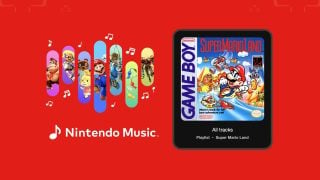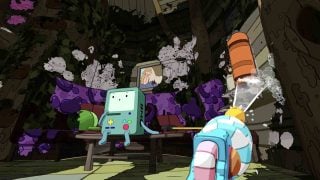Some memories just have a way of sticking with you and when it comes to my own gaming history one of those memories is the first time I ever played a GameCube. It was my birthday and my mom surprised me by renting the system from Blockbuster and inviting my friends over to check it out. The startup screen, with its distinct music and visual, blew me away and as Super Smash Bros. Melee’s own iconic intro movie started to play I knew this was leaps and bounds ahead of anything I had seen on an N64. This was something powerful and exciting and new, and while if I had any sense of technical specs or business acumen at the time maybe that sort of thinking would have been a little more jaded but for young, wide eyed, excitable me it was a revelation. This was special, and opened to door to so much more than jagged polygons. Like its Dolphin codename it was sleek, fluid, and altogether mysterious to me. Once the party was over I gave Luigi’s Mansion a try and had that same reaction all over again, reminding me why Nintendo is a company I love to support and savor. I’d only spent a few hours with the system and these two games but I knew exactly what was going on my Christmas list that year.
It’s been fifteen years since the GameCube was released and in retrospect I feel it might be one of the finest of Nintendo’s home consoles. There are three main things that I think bear mentioning when it comes to the Cube, each of which played a part in making it special to me. While everyone’s opinions and experiences may be different, I feel they’re also a great representation of its strengths as a whole. The first of these is the controller, which to this day is one of my all time favorites for not just Nintendo but all platforms. Maybe it’s the fact that, thanks to Brawl and Smash for Wii U, I’ve been using one for fifteen years, but the GameCube controller just feels right in my hands. The face buttons are each shaped differently, the shoulder triggers felt satisfying to press (even with that unmistakable clacking), and the dual stick design was something new for Nintendo.
Having grown up on the N64 controller’s tri-handle design there was a sense of completeness with a controller that fit so well in my hands without a third of it floating off to the side, untouched in several games. Having rumble built in to the controller eliminated the need for the cumbersome (but still loved) pack and allowed games to implement the feature across the board. It was also the first foray into wireless controllers for Nintendo via the Wavebird, coming later in the console’s life. While the original wired feels “most right” to me I can’t deny that I always favored using a Wavebird if only for the convenience of having no wires for my dog to potentially chew or trip on.
A system stands and lives by its library and in that department I feel the Gamecube was a resounding success. The two games mentioned already, Melee and Luigi’s Mansion, became instant classics. Luigi’s Mansion captured the atmosphere of a haunted mansion in the Mario world perfectly and allowed Luigi a chance to really shine in his own game, setting the stage for this darkhorse to become a more fleshed out character and get his very own year over a decade later. Melee is still thriving in fighting game tournaments to this day due to its fast pace and tight controls, and with its supreme amount of Nintendo references and unlockables it was almost a mini museum to the companies past and present, a trend that continues with each new installment of the series. These are only two of the games for the system and the hits and surprises kept on coming throughout its life, though I have to mention Paper Mario: The Thousand Year Door in particular for being not just a great Mario RPG but one of my favorite RPGs of all time and the reason why I hold that series so dearly in spite of some more modern missteps.
Plenty of risk and experimentation came in the Cube’s history, two of the most well known being universally rejected upon their reveal. The Legend of Zelda: The Wind Waker was reviled upon its unveiling, the shaded and stylized look being branded “childish” and drove people to swear off the game based only on this first look. Today it’s perhaps one of the most universally loved in the series alongside Ocarina of Time and Link to the Past due to the well crafted world its expressive characters inhabited, its multiple islands all bearing exploration and discovering much like the very first game’s caves. All of that with an entertaining narrative and it’s no wonder it received an HD remaster to remedy the few problems people had with it, such as the pacing of sailing around the world.
Metroid Prime went the other direction, becoming a “mature” first person shooter game with detailed graphics and seemingly no exploration in sight. It’s now known as one of the finest in the franchise alongside Super Metroid. It successfully captured the isolated, explorative, empowering feel of Metroid while expanding the franchise’s mythology without compromising the established narrative. Even with the new point of view they integrated it wonderfully, putting you behind the visor of a top class bounty hunter and making for an experience that hasn’t been topped in its series yet.
Other standouts of this ilk include Kirby Air Ride, the one button racer whose City Trial mode is still a complete blast to play with friends; Pokémon Colosseum, a unique take on the world with its themes of corruption and the ability to technically “steal” Pokémon; and Super Mario Sunshine which saw Mario utilizing a water pack more than his trademark jumping to explore one of the finest examples of a 3D platforming world in modern memory. Others like Mario Kart: Double Dash!! (exclamation marks mandatory) and Fire Emblem: Path of Radiance were well done examples of their existing franchises, showing differences from previous entries less drastic but still enough that they couldn’t have existed if not on the Cube.
There were some fantastic new additions to the Nintendo stable of worlds and characters via the GameCube as well. The biggest success story has to be Pikmin, the imaginative strategy game from Shigeru Miyamoto. Utilizing the increased power of the hardware it allowed you to control up to one hundred distinct characters at a time, giving them commands they would follow unless interrupted. It was up to you to navigate their captivating and dangerous home planet to save Captain Olimar from an encroaching deadline (literally). It even saw a sequel on the same system that improved on it in almost every way, making the series synonymous with the GameCube to fans.
While it had already been started on the N64 in Japan, the GCN was the rest of the world’s first foray into the delightful world of Animal Crossing. Dropped into a town as a new resident amongst a cast of neighbors, shopkeepers, and travelers that go about their lives all set to the system’s internal clock, you could enjoy the game in any way you chose, with several options. There was no “goal” enforced by the game, with your experience coming down to your own accomplishments and views. The game was massive, with new copies coming with a memory card just to hold your town’s data.This philosophy makes for a sublimely relaxing experience unlike anything I’ve played before or since, and while Animal Crossing New Leaf on the 3DS may represent the strongest entry in the series I’ll always hold a softspot to my first town on the GameCube original.
The software library on the GameCube wasn’t limited to Nintendo’s own work, though. The company actually allowed other developers to utilize their franchises in a few, notable joint efforts. While some of these were ambitious yet ultimately fell a flat, such as both Star Fox titles (one each courtesy of Rareware and Namco) seen on the system, others were spectacular. F-Zero GX (developed with Sega) in particular stands out as my favorite racing game on the GCN due to its unrivaled speed, multiple game modes, and spectacular graphics maintained across all of that. Other spectacular third party releases included the Super Monkey Ball games as well as ports of otherwise Dreamcast exclusives, such as Sonic Adventure 2 and Skies of Arcadia, from Sega; the stylish and refreshingly challenging beat-em-up Viewtiful Joe from Capcom, and the Namco RPG masterpiece Tales of Symphonia (one of my favorites of all time, mind you).
The Gamecube also saw many “mature” titles developed across its life, a feat that hasn’t been matched by any of its successors save the occasional standouts. None of these used it as a selling point mind you, they were simply quality games. These included two iconic titles from Capcom: the almost universally praised action-horror title Resident Evil 4 and the unique rail shooter mind trip that was killer7. Hideo Kojima got in on the fun as well, releasing a port of the PlayStation’s Metal Gear Solid for the system. Subtitled “The Twin Snakes”, it offered updates to certain game mechanics and presentation while also remedying some of the tedium involved with backtracking found in the original release. Lastly I’d be remiss not to mention one title in particular. While there are plenty of other examples, Eternal Darkness: Sanity’s Requiem stands out as a game that managed to be compelling, unsettling, immersive, and thought provoking all at once and stands as a fine example of using the medium to enhance the overall experience.
The GameCube’s third and final claim to fame, at least to me, is the groundwork it laid for future developments from Nintendo. It was the first system from Nintendo to offer any sort of online connectivity in the modern sense through the likes of Phantasy Star Online. The aforementioned Animal Crossing allowed players to take their towns with them via their memory card, so by having two in a system at once you could travel to and from multiple towns. A bit of Super Nintendo magic was brought back via the Game Boy Player, an add on that allowed Game Boy Advance (as well as Color and original) games to be played on your TV screen much like the Super Game Boy before it.
Speaking of the Game Boy Advance, a special link cable allowed for unique experiences such as the Animal Crossing Island and e-Reader features, the Tiny Chao Garden with certain Sonic titles, and certain games built completely around the special link cable such as Final Fantasy: The Crystal Chronicles and The Legend of Zelda: Four Swords Adventures. This asymmetrical gameplay is now a cornerstone of the Wii U’s design, and it’s curious to see if the NX continues that trend.
For these reasons the GameCube is a fondly remembered console for me, one which I still play every now and then despite it celebrating its fifteenth anniversary. To me that says something about its quality, and while some might deride it for its small size and handle I embrace these quirks and everything else about the system. It might not be my favorite but as time goes on it stands out to me perhaps as the last home Nintendo console that truly held me. I’ve enjoyed the Wii and the Wii U but with a new system about half a year away I find myself looking to the GameCube’s legacy in the hopes of another, great member of the family. If that doesn’t end up happening, there’s nothing stopping me from starting up the old Cube and watching the “G” unfold for the umpteenth time and smiling all the while.
Leave a Comment








